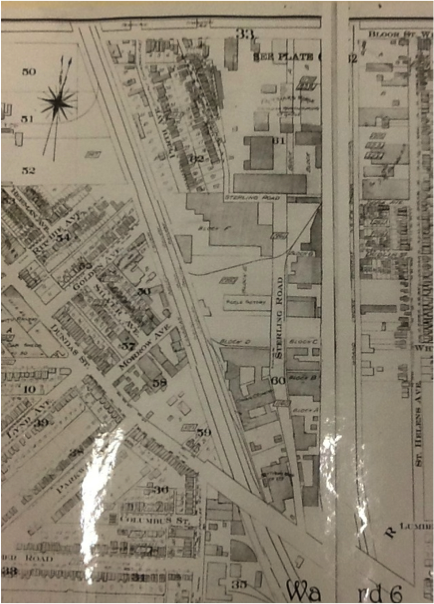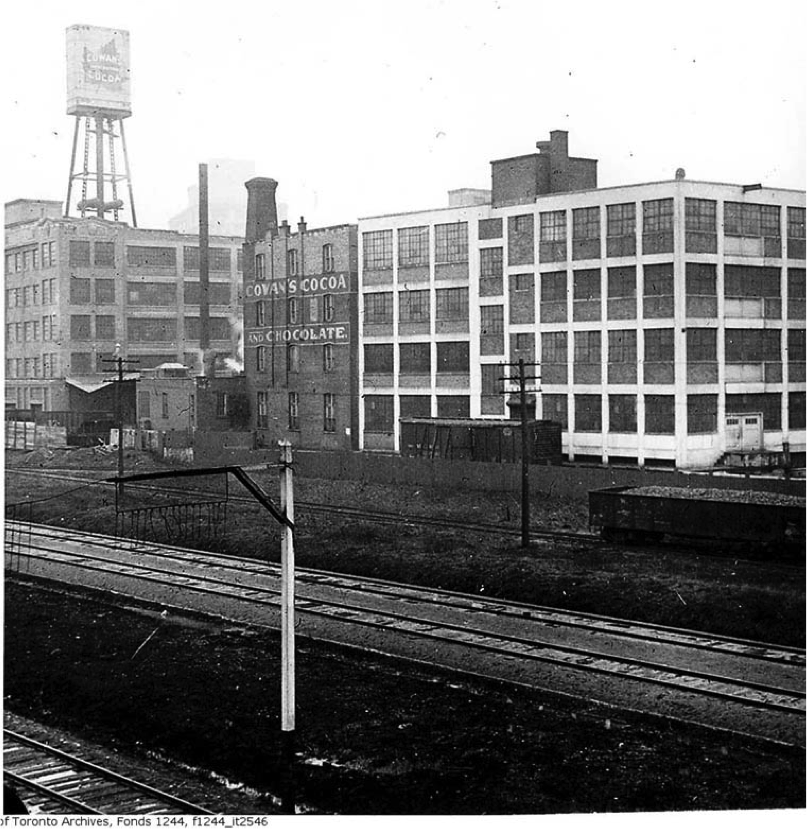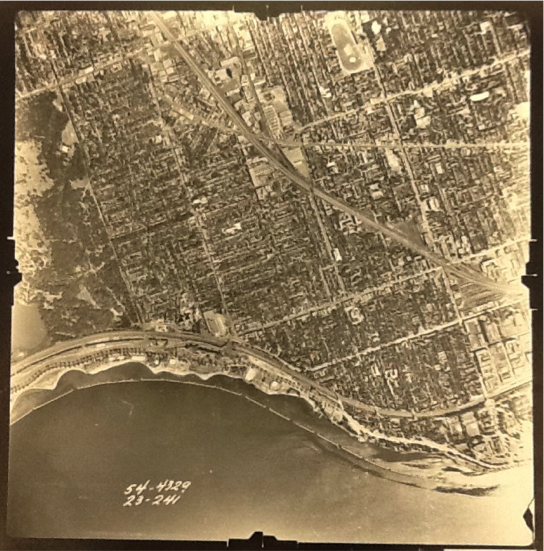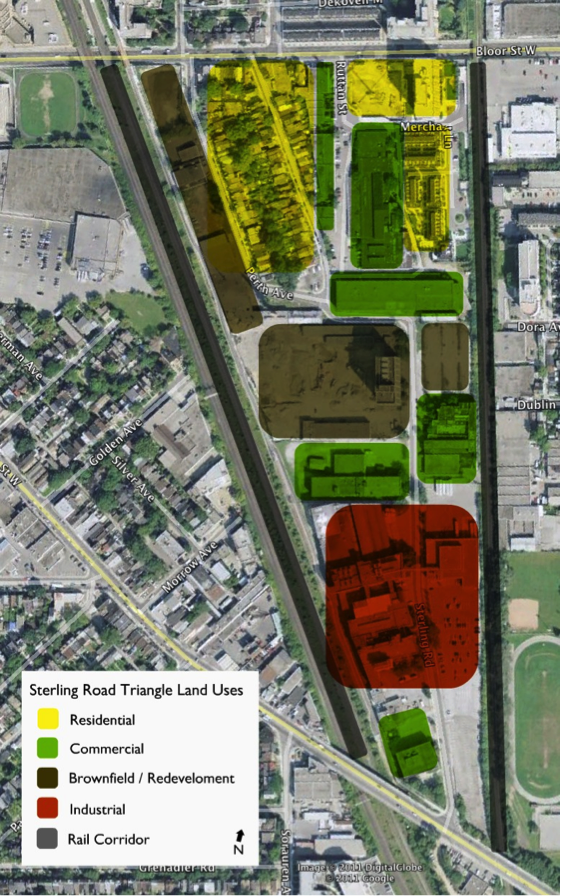
Figure 1. A 1923 fire and insurance map shows a heavy concentration of large manufacturing structures in the heart of the site of the study area by this time (Goad, 1923).
Pockets of deindustrialized facilities in downtown areas made redundant by the relocation of manufacturing and processing industries can provide built-form opportunities for new economic purposes. Exploratory fieldwork in Toronto's Junction Triangle neighbourhood reveals a collection of old industrial spaces that have been reclaimed by an assortment of entrepreneurial micro-enterprises that provide replacement employment and economic value. This micro-enterprise economy is elevated by its locational advantage, serving high-end consumption goods, services, and experiences to a gentrified urban population. The mixed-method research findings serve as a case study for the protection of industrial facilities and their potential ongoing role in the urban economy.
As Toronto city planners look for ways to increase residential density throughout the city, land assemblies in former industrial districts within the downtown area hold potential for this objective to be met. At one time, Toronto had a robust downtown manufacturing economy with facilities located along railways and waterfront areas; however, the combination of a relocation of most heavy industrial activity to the urban fringe (or overseas), together with a decades-long employment shift toward the service economy, has left several industrial-purpose facilities vacant, with the future use of these districts in question. Land developers are generally eager to see these employment areas converted to residential use to unlock potential development value, and in many cases, these settings have been redeveloped for new uses that appear more in line with the modern economy (e.g.: the condominium and box-style retail redevelopment of Toronto's Liberty Village). Despite the common desire of the development community, the employment value of former industrial districts needs to be carefully considered, especially since, in some cases, significant industrial-era buildings remain on these lands with varying degrees of potential adaptation and reuse.
Decisions about what to do with the facilities left behind as a result of deindustrialization bring into focus the nature of our future economy and the role that these facilities may play in shaping it. If there is to be no additional heavy industrial activity in Toronto's downtown area, are there new economic activities that can be nurtured and developed in the very spaces of the old economy? Can these new activities replace lost manufacturing employment and contribute to new dimensions of urban life?
Exploratory research on these questions in Toronto's Junction Triangle neighbourhood has revealed that if the conditions are agreeable—specifically, the availability of low commercial rent, the flexibility of large-format space, and the close proximity to a gentrified population—these settings can provide the conditions for a replacement economy to emerge. Located in the western part of Toronto's downtown area, the Junction Triangle is home to a mix of entrepreneurial micro-enterprises that result in a healthy—albeit modest—mix of economic production based around lifestyle goods and service offerings. The deindustrialized facilities made redundant by the migration of heavy industry act as centres of enterprising creativity and innovation built around a local market and workforce. By examining the nature and range of enterprises operating in this neighbourhood, we see that the physical legacy of the industrial era can be reused and that new economic activities can be conceived in the old industrial spaces in the downtown area.
According to Jane Jacobs, old buildings maintain important value and hold a unique function within the ecosystem of a healthy city (Jacobs, 1961). While many post-war politicians and planners across North America advocated for broad urban renewal strategies that involved severe redevelopment of 'obsolete' buildings that were seen to contribute to urban decay (Hall, 1988), Jacobs argued that cities need old buildings to thrive (Jacobs, 1961). Pitting urbanism against modernism, Jacobs argued for the protection of buildings of mixed age and condition, pointing out that not all business enterprises can afford the high costs associated with new construction (Jacobs, 1961). In addition to lower rents, deindustrialized facilities in the downtown area often have intrinsic locational advantages that make these settings attractive to re-imagined uses in the post-industrial economy. Jacobs lists neighbourhood bars, specialty restaurants, and "unformalized feeders of the arts" along with "hundreds of ordinary enterprises" as representative of the range of businesses that thrive on the lower overhead costs associated with old buildings (Jacobs, 1961, p. 188).
Downtown manufacturing facilities once held specific locational advantages for the industrial economy, such as proximity to a deep labour pool and efficient transportation access for input and output goods. While manufacturing's interest eventually shifted away from the downtown in search of a cheaper labour pool (overseas) or to the suburbs for more space, lower taxes, looser zoning, and better trucking facilities, today's economic entrepreneurs can capitalize on these same locational assets for their own purposes.
Thomas Hutton (2004, 2008) has been examining the emergence of creative, technology-intensive clusters forming within the post-industrial landscape of Vancouver's downtown area and finds that the so-called New Economy is largely responsible for the regeneration of some of that city's once-derelict industrial districts. Agents of this New Economy—sometimes referred to as knowledge workers—benefit from the interconnected nature of the globalized economy and utilize communications technology (specifically computer-based software and the internet) to offer specialized services (Alcaly, 2003, p. 20). Hutton (2008) refers to a range of enterprises engaged in industries such as software, multimedia, video production, post-production, architecture, industrial design, graphic design, and advertising as all contributing to "the New Economy of the Inner City" and restoring vitality to many of Vancouver's deindustrialized facilities (p. 987). Hutton emphasizes the value of this regeneration as a central part of any relevant city's growth economy and advocates for protecting derelict industrial facilities for the benefit of these new industry formations (Hutton, 2008).
In a similar fashion, Graeme Evans (2009) details the contribution of the "creative class" to the local economy of London and the national economy of Great Britain at large underscoring the role of that the "micro-enterprise economy" (firms with less than five employees) plays in fertilizing this economic growth. Evans details the many micro-enterprises engaged in activities such as software, visual arts, crafts, "new" media, and associated technologies, who are clustering in former industrial areas and contributing to new schemes of economic and employment production. Referring to the phenomenon of new, creative industries in old manufacturing facilities as "new wine in old bottles" (p. 1004), Evans challenges the popular efforts by various civic governments around the world who have attempted to legislate the creation of innovation hubs ex novo (often on greenfield sites) while ignoring grassroots clusters of creativity and innovation already present in the urban ecosystem.
Meanwhile, in the Williamsburg section of Brooklyn, NY, the consumer desires of this gentrified neighbourhood has led to the use of old industrial spaces for on-demand production of high-end products, according to Winifred Curran (2010). Location (and the perceived localness of the goods-maker) is described to be the elemental ingredient for the success of the manufacturers operating in the area (Curran, 2010). As Curran explains, "the creation of consumer goods in highly 'authentic' places like inner-city industrial neighbourhoods helps to create favorable 'geographic stories' that make these goods more attractive than those from other places" (p. 873). She judges that the effects of gentrification in Brooklyn and nearby Manhattan are the driving forces behind this arrival of small-scale manufacturing in Williamsburg, having "created a demand for custom furniture, high-end food products, fashion, and any number of products" (p. 881). Curran carefully highlights these niche manufacturers and the role they play in regenerating economic activity in the once-dormant manufacturing settings against the more-commonly discussed agents of the "creative class" (such as those outlined above), and argues that these traditional production activities are no less valuable to the urban economy than the coveted knowledge workers.
Located in the western part of Toronto's downtown area, the Junction Triangle occupies a wedge of land south of Dupont Avenue, just west of Lansdowne Avenue, stretching south from Dupont past Bloor Street to a pointed tip at Dundas Street West. The area's industrial character first began to take shape during the second half of the nineteenth century with the establishment of the Toronto Grey and Bruce CPR line (City of Toronto, 1979). Eventually bordered on three sides by railway tracks, the Junction Triangle was colonized by enterprising industrialists and by the start of the twentieth century, was built up with various manufacturing facilities, along with modest housing lots developed for their employees (City of Toronto, 1979). A fire insurance plan diagram from 1923 shows industrial uses accounting for an estimated 70-80% of the land use of the study area, which focuses on the southern tip of the Triangle, south of Bloor Street (see Figure 1). Some of the notable manufacturing tenants of this era include Cowan's Cocoa, T.A. Lytle Ketchup, the Aluminum Company of Canada (ALCAN, who built and occupied the landmark nine-storey tower that anchors the area), and Fairbanks Morse, a train-parts manufacturer situated on a large piece of land closer to Bloor Street (Goad, 1923).
Manufacturing played a vital role in the local fabric of this area of Toronto for the first half of the twentieth century, with these factories providing a large source of employment to the local homeowners (City of Toronto, 1979); however, forces beyond the control of local residents soon conspired to push these manufacturing jobs to larger suburban locations or overseas. Beginning in the early 1950s, the areas of the West Toronto Junction and Junction Triangle experienced a decline in manufacturing and resource processing jobs, accented by a five-year period between 1964 and 1969 when 4,000 local jobs were lost (City of Toronto, 1971).

Figure 1. A 1923 fire and insurance map shows a heavy concentration of large manufacturing structures in the heart of the site of the study area by this time (Goad, 1923).
The residents and industrial employees engaged in work here witnessed first-hand a phenomenon that was beginning to grip most of the western world at this time. The common experience was a mass deceleration of the robust manufacturing economy that had provided much of the western world with its economic growth following the industrial revolution (Bell, 1973). Spurred on by globalization and the reduction of taxes and tariffs imposed on international trade, more and more mass production and manufacturing moved overseas in search of cheaper land and labour costs (Bell, 1973). The swift erosion of the manufacturing sector promised to have a profound impact on society at large, as first suggested by American sociologist Daniel Bell (1973), whose theory of an economy based on the value of information instead of the value of goods and the creation of a knowledge class appeared in his 1973 book The Coming of Post-Industrial Society. With finance and service-sector employment now surging in the later half of the twentieth century in Toronto and other cities, the traditional industrial economy would continue to play a diminishing role going forward, leaving manufacturing sites underutilized or abandoned altogether.

Figure 2. City of Toronto Archives photo showing industrial formations lining the railway tracks in the Junction Triangle (1922).
Through much of the first three quarters of the last century, land along the railway network of Toronto housed manufacturing and processing facilities that held tangible economic value in form of well-paying jobs for local residents and accumulated wealth for factory owners. As the industrial era wound down and these factories relocated overseas or to the suburban fringe, Toronto's local economy shifted to include a higher proportion of white-collar service jobs, typically concentrated in the central business district. While Toronto's service-based economy has flourished in the post-industrial climate thanks in part to its already well-developed economic base in place before manufacturing expansion (Caulfield, 2009), the local employment opportunities that the manufacturing industry represented have largely been lost, contributing to an urban society with a diminishing middle class.

Figure 3. City of Toronto Aerial photograph of the Junction triangle study area in the context of residential neighbourhoods (1954).
Today, the southern end of the Junction Triangle includes a mix of land uses ranging from industrial, residential, and commercial (see Figure 4). The railway lines still largely define the borders of the territory, although with rail-based shipping demand reduced, some of the track space has been converted into a pedestrian and bicycle pathway (West Toronto Railpath). With the exception of the Nestle chocolate factory (still operating on the same site as Cowan's Cocoa), all heavy industrial activity has moved on, leaving behind a collection of old structures and considerable brownfield open space. The small enclave of 40 to 50 residential houses on Perth Ave. and on the north end of Sterling Road remains, while the land that once housed Fairbanks Morse near Bloor Street has been redeveloped as a condominium and townhouse complex. Finally, a group of auto-mechanics has established a presence along Bloor Street and along Ruttan Ave.

Figure 4. A satellite image of the Junction Road study area, coded for present land use type.
The Junction Triangle's Micro-Enterprise Economy
The focus of this study centres around the remaining industrial buildings that no longer serve industrial purposes on Sterling Road: numbers 128, 158, 163, 213, and 223-227. Of these five main deindustrialized facilities, one sits vacant (the monumental tower built by Alcan at 158 Sterling Road) while the other four are variously occupied. These four form the basis for the fieldwork, where I adopted a mixed-method research approach consisting of data collection and analysis along with interviews.
A completed business directory of the buildings forms the first part of the fieldwork research and reveals a wide range of mostly small (or more specifically micro-) enterprises engaged in a host of business activities from publishing to recreation services to arts and culture (see Table 1). What emerges here is a pattern of locally focused services, many relying on a local customer base: dog-walking, furniture repair, and children's gymnastics, as examples. Additionally, many of the businesses are providing high-end handcrafted consumer goods, especially in fashion and furniture-making, logically to a local (Toronto) market. Clustering appears to be a common trait, especially around fashion services in 163 Sterling Road and woodworking or furniture making in 213 Sterling Road. A high number of recreation-based services also call the Junction Triangle home, from gymnastics and circus performing, paintball to recreational axe throwing. In addition, several enterprises working directly in the arts-and-culture stream—from performance venues and galleries to artist studios—also proliferate the directory. One notable observation from this research stage was a surprising lack of businesses that are engaged in what would commonly be referred to as "knowledge work": the actors of the so-called New Economy are scarcely present on Sterling Road.
The second research method consisted of a series of ten semi-structured interviews with business operators working in the subject buildings, covering a range of business sectors, with respondents from each of the four building addresses. Each organization that I approached was open to the interview, and in all but one case the respondent was the principal or co-principal of the enterprise. During the fieldwork interviews, I attempted to gain an understanding of: (1) the size of the respondents' organizations; (2) their timing and motivation for locating in the spaces that they were now occupying; and (3) their outlook on the future of the area along with a prediction of their place within it.
Firstly, the vast majority of the businesses are micro-enterprises, with a handful of exceptions that could be listed as "small businesses." Additionally, many of the organizations are relatively new arrivals to the Junction Triangle (within the last three years). Regarding the various motivations to locate in the Junction Triangle, three factors emerged as primary draws: (1) affordability of lease; (2) the location; and (3) flexibility of space, ranked in that order, with some respondents listing all three as chief among motivating factors.
The amount of space available for relatively inexpensive rents allows the Junction Triangle enterprises to engage in creative endeavours, and is clearly an important factor in the composition of the neighbourhood today (one tenant quoted his rent at $12 per square foot per year, much less than comparable market rates of $18-$20). Regarding affordability, two of the six respondents who listed price as a central reason for locating there spoke about the Junction Triangle being an affordable haven after both were priced out of nearby Parkdale.

Table 1. Businesses and organizations operating out of the Junction Triangle case study buildings, April 2012.
The connected urban location, and even the "industrial-type vibe" of the neighbourhood, was a strong attractive force for five of the ten respondents. The gymnastics company capitalizes on the location by marketing its programs to the nearby neighbourhoods of Roncesvalles and High Park, while one furniture retailer cites the local demand for high-end home furnishing as a reason for having chosen the site. Meanwhile, a newly established tenant that specializes in the design and assembly of high-end handcrafted furnishings highlighted the marketing value that a deindustrialized location such as the Junction Triangle provides.
Finally, many of the respondents spoke of the physical conditions of the space that allows for certain flexibility, especially for enterprises engaged in the production of handcrafted goods (art, furniture, clothing). "You need a proper space to do this kind of work professionally," said one of the respondents, who shares the lease on over 4,000 square feet with a woodworking co-op, giving them collectively the space for the necessary tools required for furniture processing. Other artists and artisans engaged in large-format work and performance-based professions also stressed the important role that large space plays in their ability to be successful.
The micro-enterprise community that has repopulated this series of deindustrialized facilities in Toronto's Junction Triangle represents a diverse mix of creative businesses and organizations who are taking advantage of a combination of cheap rents, urban location, and flexible physical space in order to thrive. The emerging economic vitality that these enterprises represent reinforces a message preached by Jane Jacobs (1961), who insisted that cities need old buildings with low barriers of entry in order to incubate new ideas and to house new ventures. Many of these Junction Triangle micro-enterprises are involved in creative and innovative areas operating decidedly outside of the mainstream knowledge economy. While the old industrial space gives these enterprises a certain degree of flexibility and room to experiment, what binds these enterprises together and keeps them thriving in this environment appears to be the very urbanity of this deindustrialized location.
Relating back to the experience of Williamsburg, Curran offers a theoretical voice that could readily apply to the micro-enterprise economy that forms the basis of this study: "Gentrification creates demand for products that local manufacturers can supply. Small, local manufacturers are ideally suited to the small-batch, flexible production process necessary to respond to the ever changing demands of the population" (p. 881). An influx of greater wealth into the city's west-end neighbourhoods has provided a healthy customer base to support this pocket of entrepreneurial micro-enterprises.
During the industrial era this corner of the city was a node of economic production and employment, and this latest regeneration is once again breathing life into it as a productive economic centre. The renewal has both real and symbolic importance. Locations such as the Junction Triangle provide niche services and diverse employment possibilities, even if on a modest scale compared to the overall regional economy. But just as gentrification brought on residential displacement in nearby neighbourhoods such as Parkdale, Bloordale, Dufferin Grove, and Roncesvalles, the same processes of displacement appear to be on the near horizon for a handful of the study's micro-enterprise tenants, especially those collectively owned organizations that are engaged in experimental arts who fear an imminent increase in rental costs as a result of development projects planned nearby. The protection of such a diverse and creative economy is important, as it exists as a symbol of larger economic diversity and growth for the city or region.
As Hutton (2008) points out, rebirth of former industrial spaces in downtown areas can have a significant impact on "the reconfiguration of the metropolitan core's space-economy, redressing to some extent the spatial imbalance of the post industrial core which heavily favoured the corporate complex of the CBD [Central Business District], and partially offsetting job losses in central city industries and occupations" (p. 9). Furthermore, the diversity and independent spirit of the micro-enterprise economy in the Junction Triangle works against a dominant neo-liberal, one-size-fits-all urban theory by injecting unique goods and experiences (recreational axe throwing, for instance) into the consumption offerings for its urban market.
The examination of the recent emergence of an entrepreneurial micro-enterprise economy in the deindustrialized spaces of the Junction Triangle suggests that under the right conditions, replacement economies can emerge in the settings of outmoded economic production and employment. These micro-enterprise economic actors can have legitimate value in fertilizing the larger creative sector and thus the economy of the city at large. Studying the Junction Triangle, the following conclusions can be drawn:
The deindustrialized facilities of the Junction Triangle are home to a diverse range of legitimate micro-enterprises, engaged in a variety of creative and innovative endeavours.
The collection of micro-enterprises is valuable in terms of its employment benefit and its symbolic contribution to the overall urban economy.
The micro-enterprises in the Junction Triangle are generally focused on providing high-end lifestyle consumption goods and services to a local audience.
Urban location matters. The situated locational advantage of the Junction Triangle's deindustrialized facilities, which sits amidst gentrified residential neighbourhoods, has provided the businesses and organizations with the market necessary to succeed.
Protecting the city's emerging economies and labour pools needs to be a top priority for contemporary city planners. Niche and small-scale producers should not be taken for granted. Too often, cities over-value the benefits of residential growth and in the process overlook grassroots economic formations naturally clustering in the urban fabric (Curran, 2010). Local governments have the tools to protect emerging economic configurations such as this one through zoning and land use policies, development regulations, rent controls, and design guidelines (Hutton, 2004). Based on the potential creative, innovative, and economic contributions to urban life that deindustrialized spaces can provide through adaptive new uses, the protection of the physical legacy of buildings and infrastructure left from the industrial era must be considered when developing the new city.
Alcaly, R. (2003). The new economy. New York: Farrar, Straus and Giroux.
Bell, D. (1973). The coming of post-industrial society: A venture in social forecasting. New York: Basic Books.
Caulfield, J. (2009). Toronto: The form of the city. In H. Hiller (Ed.), Urban Canada (2nd ed.) (pp. 312-342). Oxford: Oxford University Press.
City of Toronto (1971). Report on industry: Survey of the western area. Toronto: City of Toronto Planning Board.
Curran, W. (2010). In defense of old industrial spaces: Manufacturing, creativity and innovation in Williamsburg, Brooklyn. International Journal of Urban and Regional Research, 34(4), 871-885.
Evans, G. (2009). Creative cities, creative spaces and urban policy. Urban Studies, 46(5-6), 1003-1040.
Goad, C. (1923). Atlas of the City of Toronto and suburbs. Toronto: Charles Goad.
Hall, P. (1988). Cities of tomorrow: An intellectual history of urban planning and design in the twentieth century. Oxford: Basil Blackwell.
Hutton, T. A. (2004). Post-industrialism, post-modernism and the reproduction of Vancouver Central Area: Retheorising the 21st-century city. Urban Studies, 41(10), 1953-1982.
Hutton, T. A. (2008). The new economy of the inner city: Restructuring, regeneration and dislocation in the twenty-first-century metropolis. Abingdon: Routledge.
Jacobs, J. (1961). The death and life of great American cities. New York: Vintage Books.